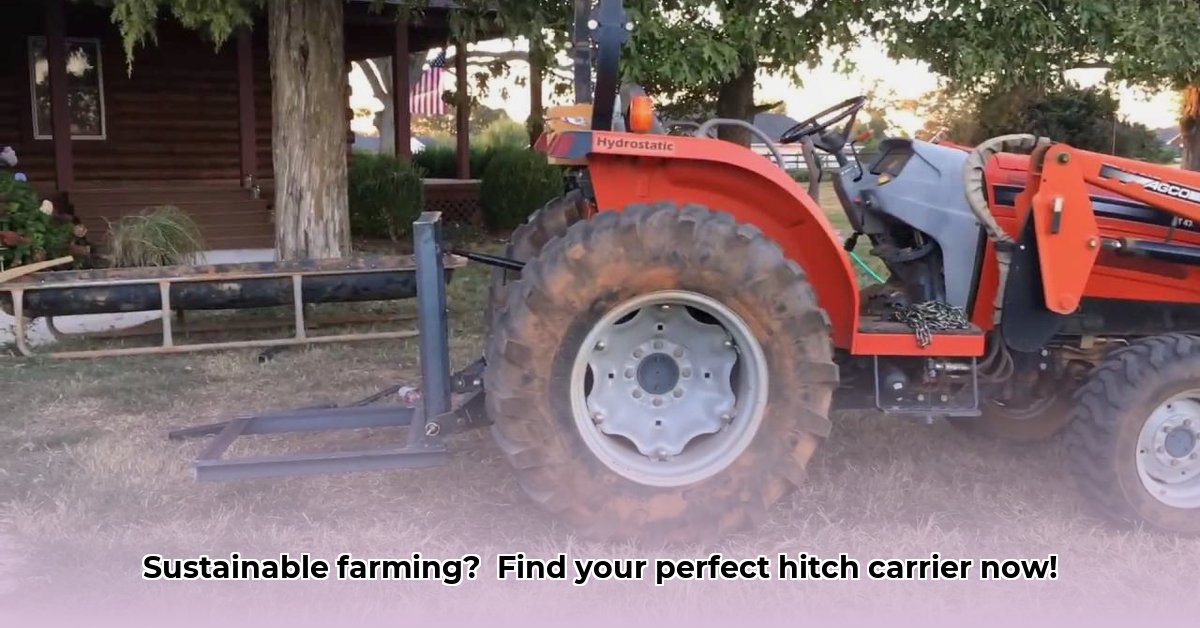
Choosing the right hitch carrier for your farm is crucial for efficient and safe transportation of equipment and supplies. This comprehensive guide will help you navigate the selection process at Tractor Supply, ensuring you choose a hitch carrier perfectly suited to your sustainable farming practices. We’ll cover everything from selecting the appropriate carrier to safe towing and maintenance. For additional cargo securing options, check out these Tractor Supply Cargo Nets.
Understanding Your Hitch Carrier Options at Tractor Supply
Tractor Supply offers a diverse range of hitch carriers, each designed for specific needs and weight capacities. Understanding these differences is key to making an informed decision. What are your heavy-hauling needs?
Key Factors to Consider:
Weight Capacity: The maximum weight a carrier can safely handle. Always choose a carrier with a significantly higher weight capacity than your heaviest anticipated load. Underestimating this is a major safety risk. (Don't forget to account for the weight of the carrier itself!)
Materials: Steel carriers tend to be more robust and durable, suitable for heavy-duty applications. However, they're heavier. Aluminum carriers are lighter, easier to handle, and less expensive but might not withstand extremely heavy loads or harsh conditions. Which material best suits your workload and tractor's capabilities?
Features: Look for features like integrated ramps (for easier loading of heavy equipment), multiple tie-down points (to secure your cargo firmly), and adjustable heights (to accommodate different tractors). These seemingly small features can dramatically improve efficiency and safety.
Picking the Perfect Hitch Carrier: A Simple Decision-Making Process
Selecting the correct hitch carrier involves considering several key factors. Getting this right is about maximizing safety and efficiency. How much weight will your carrier need to bear regularly?
Assess Your Tractor's Towing Capacity: Consult your tractor's owner's manual to determine its maximum towing weight. Never exceed this limit. This is a critical safety parameter.
Analyze Your Typical Hauling Needs: What types of equipment and supplies will you be transporting most often? Consider the weight and dimensions of your usual loads. Do you mostly haul hay bales, small tools, or heavy machinery parts?
Determine Your Budget: Hitch carriers vary significantly in price. Setting a budget beforehand will help you focus on options within your price range. While the cheapest option may be tempting, invest in a durable carrier that will last, saving you money in the long run.
| Tractor Size | Typical Hauling Needs | Suggested Hitch Carrier Type |
|---|---|---|
| Compact/Sub-Compact | Light equipment, small supplies | Lightweight aluminum or smaller steel carrier |
| Mid-Size | Moderate equipment, larger supplies | Medium-duty steel or larger aluminum carrier |
| Large/Heavy-Duty | Heavy equipment, large quantities of supplies | Heavy-duty steel carrier |
Remember, this is a guideline. Always consult the manufacturer's specifications for compatibility and safety.
Safe Installation and Usage: A Step-by-Step Approach
Improper installation is extremely dangerous. Following these steps precisely is paramount to safe operation. How would you rate your knowledge of hitch-carrier installation?
Consult Manuals: Begin by carefully reviewing both your tractor's and the hitch carrier's instruction manuals. These provide crucial details specific to your equipment.
Align and Secure: Carefully align the hitch carrier with your tractor's hitch receiver. Ensure a snug fit. A loose connection is inherently dangerous. Utilize the supplied hitch pin and any additional locking mechanisms.
Check Stability: Before loading, gently rock or move the tractor to assess the stability of the hitch carrier connection. Any excessive movement indicates a problem that needs correction.
Load Carefully: Distribute weight evenly across the carrier. Heavier items should be positioned lower and centrally to avoid imbalance. Secure your load with appropriate tie-downs.
Never Exceed Weight Limits: This is critical—never exceed the stated weight capacity of the hitch carrier or your tractor.
Maintaining Your Hitch Carrier for Optimal Lifespan
Regular maintenance is essential to prolong the life of your hitch carrier and prevent unforeseen breakdowns. Do you have a regular maintenance schedule for your farm equipment?
Pre-Use Inspection: Before each use, inspect the carrier for any signs of damage, loose bolts, or worn parts.
Post-Use Cleaning: Clean off mud, dirt, and debris after each use, paying close attention to moving parts (hinges, latches).
Periodic Lubrication: Periodically lubricate moving components to reduce friction and increase lifespan.
Off-Season Storage: Store the carrier in a dry, protected area when not in use to prevent rust and corrosion.
Safe Towing Practices: Essential Considerations
Safe towing is crucial for preventing accidents and ensuring the longevity of your equipment. What are your typical towing conditions?
Weight Limits: Strictly adhere to weight limitations for both your tractor and the hitch carrier.
Speed Control: Reduce speed, especially on turns or uneven terrain. Slower speeds provide more control and reaction time.
Enhanced Visibility: Ensure adequate lighting, particularly at night or in low-visibility conditions. Use additional lights if necessary for large loads.
Situational Awareness: Maintain awareness of your surroundings. Plan routes carefully, accounting for turns, slopes, and potential hazards.
Pros and Cons: Steel vs. Aluminum Hitch Carriers
| Feature | Steel Carrier | Aluminum Carrier |
|---|---|---|
| Durability | High durability, ideal for heavy loads | Lower durability, susceptible to bending under heavy loads |
| Weight | Heavier, may require a more powerful tractor | Lighter, easier to handle and maneuver |
| Cost | Typically more expensive | Generally less expensive |
| Weight Capacity | Usually higher weight capacities | Usually lower weight capacities |
Choosing the best hitch carrier depends on your specific needs. The information above should help you make an informed decision. Remember, prioritizing safety is paramount. Prioritize careful planning and adherence to all safety precautions. Remember to always refer to the manufacturer's instructions for detailed guidance. Visit Tractor Supply for detailed product specifications.